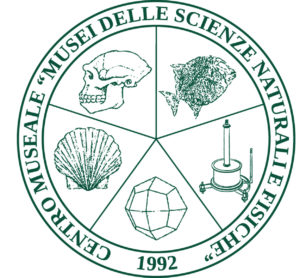 Das Paläontologische Museum in Neapel
Das Paläontologische Museum in Neapel
Museo di Paleontologia
Largo S. Marcellino, 10 80131 Napoli
Öffnungszeiten Mo bis Fr 9.00 bis 13.30, Mo und Do 14.30 bis 16.45
http://www.cmsnf.it/museo-di-paleontologia/
 Das paläontologische Museum gehört, zusammen mit dem mineralogischen, dem zoologischen, dem anthropologischen und dem Museum für Physik, zum Museumszentrum der Naturwissenschaften der Universität Neapel. Das Museum wurde 1932 gegründet, enthält aber Exponate, die von der Uni schon ab Anfang 1800 erworben wurden, wie die drei Ichthyosaurier, große Meeresreptilien, und die Fische aus Lias und Württemberg.
Das paläontologische Museum gehört, zusammen mit dem mineralogischen, dem zoologischen, dem anthropologischen und dem Museum für Physik, zum Museumszentrum der Naturwissenschaften der Universität Neapel. Das Museum wurde 1932 gegründet, enthält aber Exponate, die von der Uni schon ab Anfang 1800 erworben wurden, wie die drei Ichthyosaurier, große Meeresreptilien, und die Fische aus Lias und Württemberg.
Mit der Zeit kamen die „Sammlungen von Ittioliten“ aus Kampanien (Kreidezeit) und die bedeutende „Sammlung Costa“, einem bekannten Paläontologen aus der ersten Hälfte des 19. Jh., hinzu. Dank dieser wissenschaftlich wertvollen Fundstücke konnte man die paläoklimatischen Veränderungen im Laufe von Millionen Jahren in Kampanien verfolgen.
Seit 1996 ist in einem mit schönen Majolika aus der 18. Jh. verzierten Saal ein eindrucksvolles Skelett von Allosaurus fragilis ausgestellt, einem fleischfressenden Dinosaurier, etwa 8,5 m lang und 3,4 m groß, der aus der amerikanischen Jur- Fundgrube Morrison Formation stammt. Sein großes wissenschaftlichen Interesse verdankt das Riesenreptil seiner Authentizität. Da der Schädel sehr schwer ist, wurde er nicht auf dem Skelett montiert sondern in einem getrennten Schaukasten ausgestellt.
 The Paleontological Museum is part of Natural History Museums Centre of Naples‘ University Federico II, with the other museums of mineralogy, zoology, anthropology and physics.
The Paleontological Museum is part of Natural History Museums Centre of Naples‘ University Federico II, with the other museums of mineralogy, zoology, anthropology and physics.
Even if it was established in 1932, the Paleontological Museum has a lot of finds obtained from Naples‘ University since the first years of the 19th century as the three exemplars of Ittiosauri, big marine reptiles and fishes of Lias of Wurtemberg. Over time there were introduced the “collections of Ittioliti” coming from the three goldfields of Castellammare, Giffoni and Pietraroja of Cretacico and the important “Oronzo Gabriele Costa’s Collection” famous paleontologist and zoologist of the mid 19th century(1787-1867).
These finds are very precious because they have enabled see- kers to rebuild palo-environmental changes that took place during millions years in the Campania area. Since 1996, an awesome skeleton of an Allosaurus fragiles, carnivores dinosaur is exposed evocatively in a room, which has a 18th century maiolica floor. The skeleton is 8.5 m long and 3.4 m tall, and was found in Jurassic goldfields of the Morrison Formation in the USA. The enormous earthen reptile has a big value because it is mostly original. Since the original cranium is too much heavy, it is not assembled on the skeleton and it is safeguarded in a box.
 Il Museo di Paleontologia fa parte del Centro Musei delle Scienze Naturali dell’Università di Napoli Federico II, insieme ai musei di mineralogia, zoologia, antropologia e fisica
Il Museo di Paleontologia fa parte del Centro Musei delle Scienze Naturali dell’Università di Napoli Federico II, insieme ai musei di mineralogia, zoologia, antropologia e fisica
Anche se istituito nel 1932, il Museo di Paleontologia custodisce reperti acquisiti dall’Università di Napoli sin dai primi anni dell’800 come i tre esemplari di Ittiosauri, grandi rettili marini e i pesci del Lias del Wurttemberg. Nel tempo confluirono le “Collezioni di Ittioliti” provenienti dai tre giacimenti campani di Castellammare, Giffoni e Pietraroja del Cretacico e l’importante “Collezione di Oronzo Gabriele Costa” famoso paleontologo e zoologo della prima metà dell’800 (1787-1867). Tali reperti sono di grande valenza scientifica in quanto hanno permesso ai ricercatori di ricostruire i cambiamenti paleoambientali e paleoclimatici che si sono succeduti nel corso di milioni di anni nell’area campana.
Dal 1996, è esposto suggestivamente in una sala, dal pavimento maiolicato del 700, un imponente scheletro di Allosaurus fragilis, dinosauro carnivoro lungo 8,5 metri e alto 3,4 metri, rinvenuto nei giacimenti giurassici della Morrison Formation negli USA. L’enorme rettile terrestre ha un grande valore scientifico in quanto è in gran parte originale. Poiché il cranio originale è di notevole peso, non è stato montato sullo scheletro ed è custodito in una teca.

